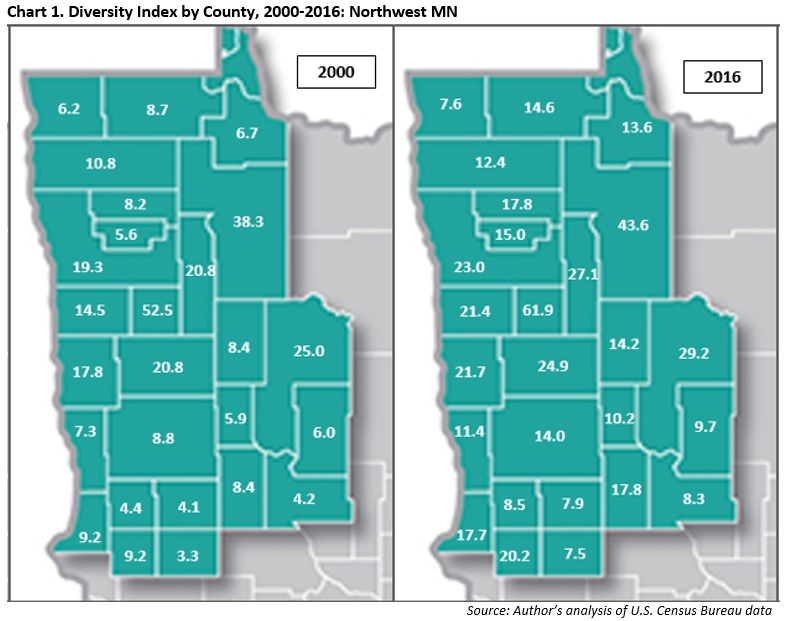 The presence of such industry powerhouses as Polaris, Arctic Cat and New Flyer make Northwest Minnesota a hub of transportation equipment manufacturing.
The presence of such industry powerhouses as Polaris, Arctic Cat and New Flyer make Northwest Minnesota a hub of transportation equipment manufacturing.
From wheat and potatoes to soybeans and sugar beets, the region is a major producer and processor of food staples and specialty agricultural products.
Want the freshest data delivered by email? Subscribe to our regional newsletters.
6/28/2018 5:00:00 PM
Chet Bodin
Despite the pending labor force shortage that Northwest Minnesota communities anticipate, the region has continued to add workers year after year. One of the most distinct features of recent labor force growth is the ethnic and racial makeup of new workers. In 2016, there were over 9,000 more minority workers than in 2000. This infusion represents 40 percent of the overall labor force growth during that time.
Regional growth in the minority labor force has been fueled by an overall ethnic and racial diversification of the region’s population. The Diversity Index allows researchers to gauge such diversification at the county level, offering a look at the distribution of racial and ethnic growth throughout the region. The Diversity Index is a number – on a scale of 1 to 100 – that represents the chance that two people chosen randomly from an area will be different by race and ethnicity. A higher number means more diversity, a lower number less.
As would be expected, the Diversity Index was highest in counties that are home to the region’s American Indian population. Mahnomen (61.9), Beltrami (43.6), and Cass County (29.2) have the three highest diversity indices, and are also co-located with Native American reservations. Having the largest American Indian population of the six regions in the state, it’s no surprise that diversity in Northwest Minnesota is highly associated with these communities.
But the region’s more recent gains are mainly being fueled by emerging minority communities in other counties. Among the top five counties where diversity has increased the most, only Mahnomen has a reservation. The rest of the top five include Stevens (+11.0), Pennington (+9.6), Red Lake (+9.4) and Todd County (+9.4).
In the five counties with the largest increase, the Hispanic or Latino population grew by an average of 392 percent, and the Black or African American population rose by an average of 248 percent. Simultaneously, these counties lost an average of 401 white residents from 2000 to 2016, which led to higher diversity scores as well.
Overall, the racial and ethnic mix in Northwest Minnesota increased across the board from 2000 to 2016, meaning that the diversity index increased in every county. The median change in diversity score by county was +4.75, resulting in a total median county score of 14.8 in 2016. In comparison, Minnesota’s statewide diversity index was 35.1 in 2016, which was exceeded by only two of Northwest’s 26 counties. Still, the region’s median growth in diversity was 64.7 percent from 2000 to 2016, and the index doubled in six counties since the turn of the century. Statewide, the diversity index grew by 44.6 percent, indicating that the rate of change was often faster in Northwest Minnesota (Chart 1).

Minority workers are a vital piece of the economy in Northwest Minnesota, and there are opportunities for others to make the region their home and earn a sustainable living. Many regional job vacancies offer wages that meet or exceed what a single person needs to cover the basic cost of living, and others offer a track toward higher earnings over time for families needing to earn more. The median wage in Northwest Minnesota now stands at $17.38, enough for most individuals and families to make ends meet and then some. Overall, there has been a momentum of diversification in the region. If other workers follow, employers and communities in Northwest Minnesota are ready to invest in them.
Contact Chet Bodin.